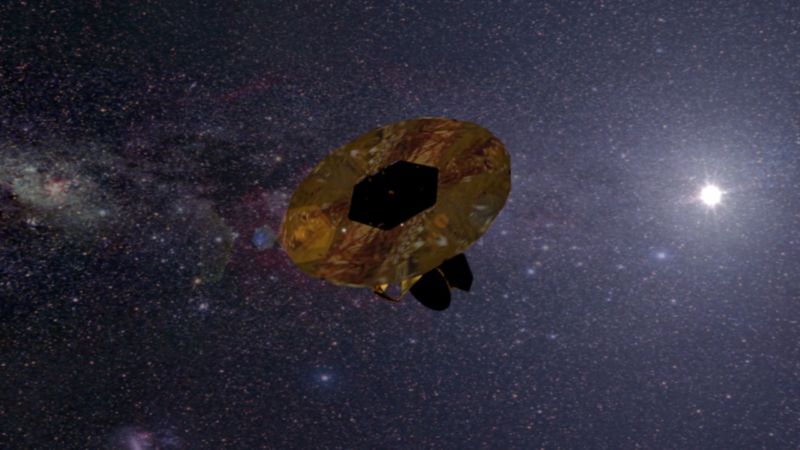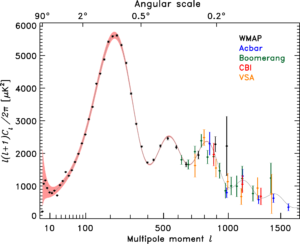
The Cosmic Microwave Background was created as the first atoms formed hundreds of thousands of years after the Big Bang, and it retains information about the formation of the Universe. Discovering it existed confirmed a key prediction of the Big Bang Model and won its discoverers a Nobel Prize. Another Nobel went to the team behind the Cosmic Background Explorer, which gave us our first look at some of the details of the Cosmic Microwave Background (CMB), providing support for the idea that the Universe underwent a period of inflation.
In some ways, these were baby steps on the route to understanding the Universe. The real leap came from lesser-known hardware with an awkward name: the Wilkinson Microwave Anisotropy Probe, or WMAP. By giving us the first detailed look at the CMB, WMAP answered everything: the age of the Universe, what it's made of, its geometry, and more.
Over the weekend, the team behind WMAP was honored with the Breakthrough Prize in Fundamental Physics, which gave us the opportunity to talk to one of its lead scientists, Princeton's David Spergel.
Spergel highlighted the role of the Cosmic Background Explorer in setting the stage for WMAP. "Soon after COBE," Spergel told Ars, "it was clear to me that, if we could measure the microwave background on smaller scales than COBE did, we'd be able to infer the geometry of the Universe—whether the Universe was flat or positively or negatively curved—measure its age and determine its composition." What was needed was a higher-resolution map than COBE had provided.
COBE had revealed that the CMB has regions where the microwaves are a tiny bit warmer or cooler than the average. To learn more, we'd have to have precision measurements of the size and magnitude of these differences, a measurement called the power spectrum. Spergel referred to this as "the lumpiness of the Universe as a function of scale."

"If we could make precise measurements of the microwave background," Spergel said, "all these questions that had kind of driven cosmology since I was a student, [questions] about the Universe's size, shape, composition, age, where do galaxies come from... we could answer all those questions with a single experiment." And that post-COBE enthusiasm seemed to be widely shared. When NASA put out a call for an Explorer-class mission in astrophysics, three of the eight proposals that were given serious consideration were on the CMB. WMAP, based in Princeton, ended up getting the nod, and Spergel led the data analysis and theoretical considerations for the team.
WMAP slowly scanned the entire sky from a position at Earth's L2 Lagrange point, building up a high-resolution map of the variations in the CMB, allowing researchers to measure the power spectrum. In the power spectrum tail, there are a series of bumps that are sensitive to everything from the geometry of the Universe to the number of neutrinos. Matching these bumps to predictions from various models of the Universe allows us to test out whether different features—the amount of dark matter, to give one example—produce a power spectrum that is consistent with what we measure.
"What we were able to do with WMAP is establish what's now the standard model of cosmology," Spergel said. "It's shown that the Universe is remarkably simple. A model with a handful of parameters—five numbers, basically—can describe not only the patterns we see in the microwave background, but really everything we see in cosmology. And while the Universe is simple, it's also really strange, in that atoms make up only five percent of the Universe, and most of the rest is filled with dark matter and dark energy." It also provided details about the first instants after the Big Bang, providing details about the Universe's period of inflation.
The basic outline of this information was apparent after just a single year of taking data. And, while WMAP was planned as a two-year mission, it released data every other year for nine years of operation. "What was remarkable to me is that, every time we got more data, the basic model fit better and better," Spergel told Ars.
-
The hot and cold fluctuations in the CMB as seen by COBE.
-
The same fluctuations as seen by WMAP.
For WMAP, the end wasn't the result of hardware failure; instead, it was moved into a parking orbit around the Sun after the ESA launched its Planck mission, with its more up-to-date hardware. Spergel has moved on to ground-based studies of the CMB, and he is currently working on a telescope that will be built in Chile. While there have been no major changes in our understanding of the CMB since WMAP, he said that hardware has improved to the point where we can get about 10 times the resolution and 30 times the sensitivity with modern instruments, and that opens up some exciting possibilities.
For one, it can give us lower uncertainties in the power spectrum measurements, and with that, better measurements of dark energy, neutrino masses, and limits on the existence of additional particles. The CMB is also imprinted with the gravitational wave background generated by the Big Bang, which could provide tests of fundamental physics if we can ever figure out how to detect it. And there's always the chance that we'll find something that WMAP didn't hint of. "The most interesting result would be that, as our data continues to improve, the model doesn't fit, that it breaks," Spergel said. "That's not absurd, because there are some intriguing tensions between the Planck measurements and measurements of large-scale structure, measurements of the expansion of the Universe."
But when we spoke, he was mostly excited about the chance for the WMAP team to get together for the first time in years and happy to think a bit about past results. "The CMB has been an incredible gift to us," he told Ars. "It's a very clean way of giving us measurements of fundamental properties of the Universe."
reader comments
29